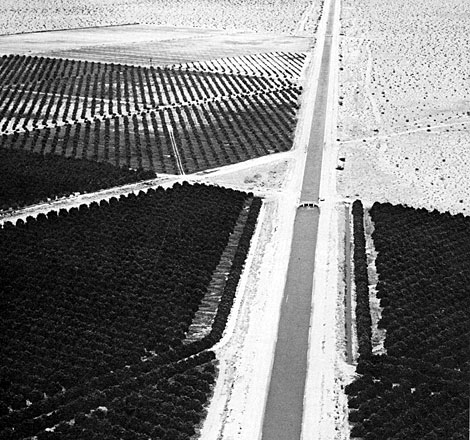

 Secretary of Interior James Watt watches as President Reagan signs the Reclamation Reform Act of 1982 into law. (Photo by Mary Anne Feckelman, The White House). Photo from The Reclamation Era, 1980. (Reclamation photograph)
Secretary of Interior James Watt watches as President Reagan signs the Reclamation Reform Act of 1982 into law. (Photo by Mary Anne Feckelman, The White House). Photo from The Reclamation Era, 1980. (Reclamation photograph)Eighty years after the signing of the Reclamation Act of 1902, the West had become one of the leading producers of agricultural products in the world, and growth turned the "Great American Desert" into a homeland for millions of people.
The success of the Reclamation program became increasingly apparent; however, while the problems the Reclamation Act of 1902 was designed to resolve were solved, a new generation of problems emerged. Over the years, the Bureau of Reclamation struggled to implement the increasingly outdated law's acreage limitation provisions while trying to keep pace with western growth. Perhaps the most troublesome stipulation of the original legislation was the 160-acre ownership limitation imposed on Reclamation farmers. This, more than any other issue, became the focus of discontent that eventually spurred congressional action.
President Ronald Reagan Signs the Reclamation Reform Act of 1982
President Ronald Reagan signed the Reclamation Reform Act of 1982 (RRA) into law on October 2, 1982, opening a new chapter in the Reclamation story in the West. "While preserving the basic objectives of the original program, this legislation provides a new direction for the federal role in Reclamation - one that will, I believe, prove to be a significant step forward on our road to economic recovery in the 1980s," the President said.
The RRA expanded ownership limits as they applied to the amount of land on which an individual could receive low-cost Reclamation project water and applied those limits uniformly throughout the West. The new acreage limitation for "qualified" recipients (individuals; individuals with spouses and dependents; legal entities with 25 or fewer beneficiaries; and tax-exempt religious and charitable groups) was expanded to 960 acres.
Separate rules and regulations applied to special circumstances, especially for situations unfavorably affected by the new regulations, and farmers along the not-yet-completed Central Arizona Project received an additional 10-year exemption for the disposal of "excess lands," referring to acreage that exceeded the 960-acre limits. Excess lands could still receive Reclamation project water, but only at full cost. In Arizona, deliveries to excess lands would only occur as the result of an oversight or mistake - a costly mistake.
The RRA was not popular in Arizona.
 Aerial view shows the contrast between irrigated citrus groves and desert near Yuma, Arizona. Photo from The Reclamation Era, 1980. (Reclamation photograph)
Aerial view shows the contrast between irrigated citrus groves and desert near Yuma, Arizona. Photo from The Reclamation Era, 1980. (Reclamation photograph)Unfortunately, the "full cost" provisions of the RRA was never compatible with CAP water deliveries. While the CAP subsidized rate was very affordable to the average farmer, a full-cost bill could be $300 and acre-foot higher. Full cost charges for project water included the "unrepaid project construction cost allocated to irrigation" on an annual basis, with interest (calculated on the average yield of U.S. securities sold during the year in which project expenditures were made, sometimes as high as 12%).
In irrigation districts throughout the west that were already paid for, or which had been built in prior years when construction costs were low, the full-cost charges could be seen as little more than a minor penalty for irrigating ineligible or excess lands. But within the CAP, which was expected to accrue construction costs in the millions, a full-cost bill based on those costs could bankrupt a farmer or a water district. Fortunately, full-cost bills were rare.
Still, the water districts were eager for a way to escape the provisions of the Reclamation Reform Act. Early on, several water districts negotiated their water rights and were forgiven their repayment debt as part of Indian water rights settlements, thus becoming exempt. By 2004, the last of the water districts regulated by the Reclamation Reform Act of 1982 relinquished their priority water rights through the Arizona Water Settlements Act in exchange for relief from their debt and became exempt from the requirements of RRA.
Sources:
Reclamation Era Magazine, 1980s, A Quantum Leap Forward: The Reclamation Reform Act of 1982 by Mitchell Snow
http://www.usbr.gov/rra/Law_Rules/public%20law%2097-293.pdf
http://www.usbr.gov/rra/
